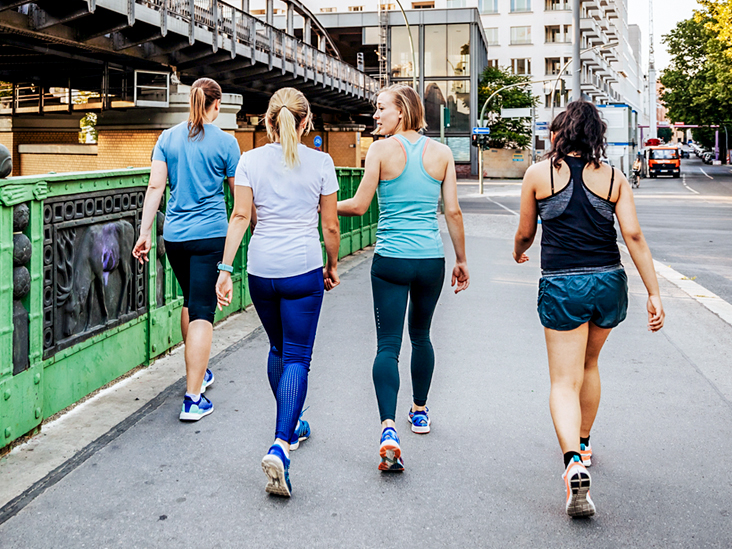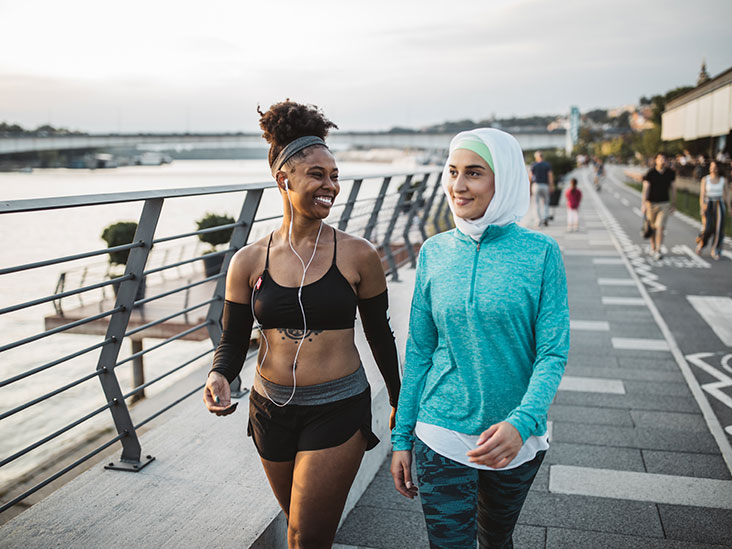A great fitness walking technique will give you better comfort, power, and speed. Whether you are a beginner or you want to improve your walking workouts, these four steps will make a difference.
Many people take up walking without thinking about the proper walking form. But your posture, foot motion, stride, and use of arm motion make a big difference in your walking speed and ability to walk energetically.
Learning to use good walking posture will help you breathe deeper, relax your shoulders and neck, and avoid back and hip pain. By using the right arm and foot motion, you will propel yourself forward with power and without wasted effort. You will use the same walking technique whether you walk on the sidewalk, track, or treadmill.
Walking Posture
Posture is the first step for walking comfort and energy. Good walking posture allows you to take full breaths, engage your core muscles, and use your leg and buttock muscles for a natural walking stride. It is also an antidote to the hunching and slouching many people do at work and when using a mobile phone.
Bad walking posture can contribute to aches and pains after walking, while great walking posture can relieve them. At the start of every walk, take a few seconds to set your walking posture.
Steps for Great Walking Posture
- Stand up straight with your feet together a comfortable space apart. Your toes should be pointed forward, but a slight angle is acceptable.
- Imagine a string attached to the top of your head. Feel it lift you up from your hips so you are tall and straight. Do not lean forward or backward.
- Don’t arch your back.
- Suck in your stomach slightly, engaging your core muscles. This will help maintain proper posture while walking.
- Maintain a neutral pelvis, not tipping your hips forward or back, to allow for your spine’s natural curves.
- Focus your eyes 10 to 20 feet ahead of you. Your head will follow where your eyes are looking.
- Keep your chin parallel to the ground. You probably already corrected this by looking ahead of you, but take a moment to check that your chin isn’t tilted either up or down. Walking with your head down (say, when checking your phone) creates tension in your upper body and puts a strain on your neck, as does craning your neck backward. Plus, you miss the beautiful, energizing scenery around you.
- Shrug your shoulders and let them relax, with your shoulders slightly back. This will help relieve the tension so many people carry in our shoulders. It will also set your position for using arm motion. Now you have the right posture to get started walking.
Arm Motion
Purposeful arm motion can lend power to your walking, burning 5% to 10% more calories and acting as a balance to your leg motion. It is common to speed up when you add arm motion.
Many poor examples of “speedwalking” arm motion are seen in popular culture, with arms pumped high in the air, crossing the body, or extending out. That kind of arm motion does not help you.
Steps for Proper Walking Arm Motion
- Bend your elbows 90 degrees.
- Partially close your hands, but do not clench them. Clenching your fists can raise your blood pressure.1
- With each step, the arm opposite your forward foot comes straight forward, not diagonally.
- As the forward foot goes back, the opposite arm comes straight back.
- Keep your elbows close to your body; don’t chicken wing (flapping your elbows out).
- Your forward hand should not cross the center point of your body.
- When coming forward, your hand should be kept low, no higher than your breastbone.
- If you find adding arm motion tiring, do it for 5 to 10 minutes at a time and then let your arms relax and swing naturally at your sides.
Foot Motion
The walking step is a rolling motion. Flexible shoes will ensure you are able to roll through the step. If your feet are slapping down rather than rolling through the step, your shoes may be too stiff.
Proper Walking Step Motion
- Strike the ground first with your heel.
- Roll through the step from heel to toe.
- Push off with your toes.
- Bring the back leg forward to strike again with the heel.
At first, your shin muscles may tire and be sore until they are strengthened. This is natural when you first start walking for fitness or when you change your foot motion, stride or shoes.
Walking Stride
The push off by your rear foot is the key to walking with power and speed. Unfortunately, many people fall into the bad habit of overstriding—taking a longer step in front. This puts more stress on your lower leg joints, and it doesn’t give your stride power.2 Ask a friend to watch you walk to see if you are overstriding with your usual walking pattern.
Practice Your Stride
As you walk with the good posture and roll-through from heel to toe, concentrate on keeping the back foot on the ground longer and giving yourself a good push off. Think about keeping your stride shorter in front.
As you get comfortable with this new walking pattern, you can increase speed by taking more, smaller steps. This is what fast walkers do rather than overstriding.
Lengthen Your Stride in Back
Focus on shortening your front step first. Next, if you like, you can also lengthen your stride in back to improve power and efficiency in your stride. Your forward foot should strike closer to your body. You don’t gain anything by stepping out farther with your forward foot.
Think about keeping your back foot on the ground longer and giving yourself a good push off to add power to your stride. Your feet are rolling through the step from heel strike in front to pushing off with your toes in back.






